Wreck Beach
Wreck Beach (Squamish: Ts'at'lhm) is a clothing-optional beach located in Pacific Spirit Regional Park, which is in turn part of the University Endowment Lands just west of Vancouver, British Columbia, Canada. The clothing-optional section is clearly marked with signs and stretches approximately 6.7 kilometres or 4.2 miles from Acadia Beach, in the north, to the Booming Grounds Creek on the north arm of the Fraser River. The park is administered by the Greater Vancouver Regional District (GVRD), though Indigenous claims are repeatedly asserted, especially by the Musqueam.
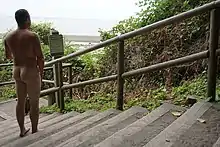
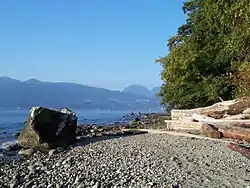

History
The earliest evidence of Indigenous peoples inhabitation dates back to 13,000 B.C. being the hunting, fishing, logging, spiritual connection grounds for the Musqueam Nation, referred to as “Ulksen” or “the nose”. [1] The beach is man-made, reclaimed from the sea in a joint venture with the Canadian Army and UBC to train cadets for beach landings in WWI, hence the presence of the "instrument towers". In the Great Depression, nude bathing became popular due to high costs of swimsuits with men congregating on Siwash Rock in Stanley Park, in order to escape the puritanicalist oppression of local residents, a legacy of the Victorian era, they then flocked to Wreck. The beach increased in popularity with hippies until the late 1960s when a police raid in 1970 yielded a dozen arrests. The Georgia Straight staged a nude-in protest with 3,000 showing up and the charges were dropped, with the police designating the area as a "no-harm, no-foul zone" until 1991 when it was officially designated a legally recognised nudist beach. [2]
Acadia Beach – Tower Beach – Point Grey
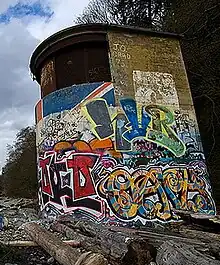
The shoreline throughout these beaches is mainly rocky with some sandy stretches with fewer beach-goers. An area is provided for owners to have their dogs off leash. During the smelt season, naturists share this area with nude fishers and their families. Smelt fishing is typically prohibited from the middle of June to the middle of August.
Acadia Beach is short walk down a gentle slope from the parking lot on Marine Drive where there is a grassy area with several picnic tables. Tower Beach is at the end of the much longer Trail 3 and Point Grey is near the steeper Trail 4. There is pay parking close to Trail 3 and 4 at the Museum of Anthropology. All of Wreck Beach is contiguous and it is possible to walk along the entire coastline. However, when the tide is too high, access can be limited.
Along Tower Beach are two tall concrete range/direction instrument towers that are relics from World War II.
Along with lush vegetation, various forms of wildlife can also be seen, including nesting herons, sea lions, kingfishers, and bald eagles.
Wreck Beach proper and Trail 6
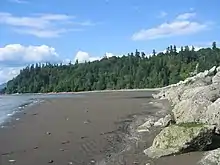
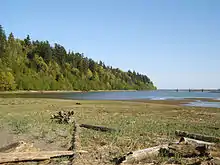
While the entire 7 km beach around to Point Grey from Acadia Beach to Booming Ground Creek is often referred to as Wreck Beach, the large sandy area on the north side of the North Arm Breakwater at the base of Trail 6 is what many think of when they talk about Wreck Beach. The trail is the most developed of the trails down the bluff and has 490 wooden steps set into the soil. At the bottom of Trail 6 is the most popular portion of the beach, a stretch of sand between two artificial rock jetties constructed as breakwaters, lined by a row of licensed vendors selling imported clothing, jewelry, drinks, snacks, and other beach related items. Other unlicensed vendors may be found wandering the beach selling alcoholic beverages and other more illicit cash crops of British Columbia.
Clothing is optional throughout Wreck Beach. Due to Wreck Beach's proximity to the University of British Columbia, many students and some faculty and staff visit the beach. In recent years many beach users have objected, on both privacy and environmental grounds, to the University's plans to construct new buildings close to the cliff edge and partially overlooking the beach.
Swimming and ocean water quality
Swimming is popular at Wreck Beach, primarily as brief "dips" for beachgoers to cool off. Since the ocean water is quite cold, swimming far from shore without a wetsuit and partner is not advised. Ocean waves in the summer, when present, are quite small and usually do not pose a risk to swimmers or waders. Rip currents are not known to be a problem and advisories are not usually posted. Caution should be taken when diving or jumping into the water to avoid any submerged rocks. Adverse interactions with marine wildlife or flora are unlikely, but jellyfish should be avoided as a precautionary measure. Small pleasure boats may anchor close to the beach and swimmers should avoid potential collisions with them.
A few times over the years, Metro Vancouver health authorities have issued advisories that the ocean's coliform bacteria counts near the beach are relatively high, and there may be potential risk to swimmers. However, Wreck Beach tends to have lower counts than many Vancouver beaches and gastrointestinal illness is generally unlikely.
See also
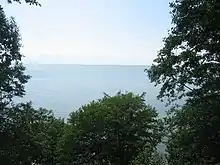
References
- "Wreck Beach Trail 4 (Towers Beach)". theswimguide.com. Retrieved July 13, 2023.
- {{cite web}|url=https://www.vanmag.com/city/general/city-informer-why-is-wreck-beach-a-nude-beach/ |title= City Informer: Why is Wreck Beach a Nude Beach? |last=McLachlan |first=Sarah |date=August 6, 2021 |access-date=July 13, 2023}}
Further reading
- Carellin Brooks, Wreck Beach (book), Number 16 in the Transmontanus series from New Star Books, Vancouver, British Columbia, Canada; www.NewStarBooks.com. Issued 2007 August. ISBN 978-1-55420-031-3; ISSN 1200-3336 Number 16.